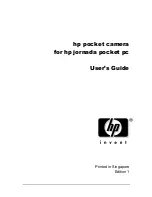
MHS-TS22
– 2 –
Camera
[System]
Image device: 4.5 mm (1/4 type) CMOS sensor
Total pixel number of camera:
Approx. 5 110 000 pixels
Effective pixel number of camera:
Approx. 3 110 000 pixels (still image, 16:9),
Approx. 5 030 000 pixels (still image, 4:3),
Approx. 3 110 000 pixels ([1920×1080 30p]
movie)
Lens: F2.8
f = 4.1 mm (3/16 inches)
When converted to a 35 mm still camera
For movies: 47 mm (1 7/8 inches) (16:9)
For still images: 41 mm (1 5/8 inches) (4:3)
Exposure control: Automatic exposure
File format:
Still images: JPEG (DCF Ver. 2.0, Exif Ver.
2.3, MPF Baseline) compliant
Movies: MPEG-4 AVC/H.264 (MP4)
Audio:
MPEG
AAC
Recording media: Internal Memory (Approx.
3.9
GB)
• When measuring media capacity, 1 GB equals
1 billion bytes, a portion of which is used for
system management and/or application files.
Available user capacity is as below.
Approx. 3.7 GB
[Input and Output connectors]
HDMI jack: HDMI mini connector
Built-in USB arm: type A (built-in)
USB communication: Hi-Speed USB (USB 2.0
compliant)
[LCD screen]
LCD screen: 6.7 cm 2.7 type (16:9) TFT drive
Total number of dots: 230 400 (960 × 240) dots
[Power, general]
Power:
Built-in rechargeable battery pack
USB
charging
Charging time: Approx. 210 mins. (full charge)
(when charging from the USB connector of
the computer)
Power consumption (during shooting): 1.5 W
(when the movie image size is [1280×720
30p])
Operating temperature:
0°C to 40°C (32°F to 104°F)
Storage temperature:
–20°C to +60°C (–4°F to +140°F)
Dimensions (Approx.):
59.6 mm × 116.5 mm × 21.0 mm
(2 3/8 inches × 4 5/8 inches × 27/32 inches)
(W/H/D, excluding protrusions)
Mass:
Approx. 148 g (5.2 oz)
Microphone: Monaural
Speaker: Monaural
Design and specifications are subject to change
without notice.
SPECIFICATIONS
SAFETY-RELATED COMPONENT WARNING!!
COMPONENTS IDENTIFIED BY MARK
0
OR DOTTED LINE WITH
MARK
0
ON THE SCHEMATIC DIAGRAMS AND IN THE PARTS LIST
ARE CRITICAL TO SAFE OPERATION. REPLACE THESE COMPO-
NENTS WITH SONY PARTS WHOSE PART NUMBERS APPEAR AS
SHOWN IN THIS MANUAL OR IN SUPPLEMENTS PUBLISHED BY
SONY.
ATTENTION AU COMPOSANT AYANT RAPPORT
À LA SÉCURITÉ!
LES COMPOSANTS IDENTIFIÉS PAR UNE MARQUE
0
SUR LES
DIAGRAMMES SCHÉMATIQUES ET LA LISTE DES PIÈCES SONT
CRITIQUES POUR LA SÉCURITÉ DE FONCTIONNEMENT. NE REM-
PLACER CES COMPOSANTS QUE PAR DES PIÈCES SONY DONT
LES NUMÉROS SONT DONNÉS DANS CE MANUEL OU DANS LES
SUPPLÉMENTS PUBLIÉS PAR SONY.
SAFETY CHECK-OUT
After correcting the original service problem, perform the following
safety checks before releasing the set to the customer.
Caution
Danger of explosion if battery is incorrectly replaced.
Replace only with the same or equivalent type.
Dispose of used batteries according to the instructions.
1. Check the area of your repair for unsoldered or poorly-soldered
connections. Check the entire board surface for solder splashes and
bridges.
2. Check the interboard wiring to ensure that no wires are “pinched”
or contact high-wattage resistors.
3. Look for unauthorized replacement parts, particularly transistors,
that were installed during a previous repair. Point them out to the
customer and recommend their replacement.
4. Look for parts which, through functioning, show obvious signs of
deterioration. Point them out to the customer and recommend their
replacement.
5. Check the B+ voltage to see it is at the values specified.
6. Flexible Circuit Board Repairing
• Keep the temperature of the soldering iron around 350°C during
repairing.
• Do not touch the soldering iron on the same conductor of the circuit
board (within 3 times).
• Be careful not to apply force on the conductor when soldering or
unsoldering.
UNLEADED SOLDER
This unit uses unleaded solder.
Boards requiring use of unleaded solder are printed with the lead free
mark (LF) indicating the solder contains no lead.
(
Caution:
Some printed circuit boards may not come printed with the
lead free mark due to their particular size.)
: LEAD FREE MARK
Be careful to the following points to solder or unsolder.
• Set the soldering iron tip temperature to 350°C approximately.
If cannot control temperature, solder/unsolder at high temperature
for a short time.
Caution:
The printed pattern (copper foil) may peel away if the
heated tip is applied for too long, so be careful!
Unleaded solder is more viscous (sticky, less prone to
flow) than ordinary solder so use caution not to let solder
bridges occur such as on IC pins, etc.
• Be sure to control soldering iron tips used for unleaded solder and
those for leaded solder so they are managed separately. Mixing un-
leaded solder and leaded solder will cause detachment phenomenon.


































